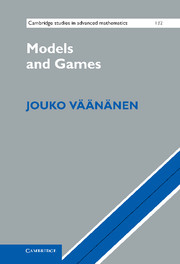1 - Introduction
Published online by Cambridge University Press: 01 June 2011
Summary
A recurrent theme in this book is the concept of a game. There are essentially three kinds of games in logic. One is the Semantic Game, also called the Evaluation Game, where the truth of a given sentence in a given model is at issue. Another is the Model Existence Game, where the consistency in the sense of having a model, or equivalently in the sense of impossibility to derive a contradiction, is at issue. Finally there is the Ehrenfeucht–Fraïssé Game, where separation of a model from another by finding a property that is true in one given model but false in another is the goal. The three games are closely linked to each other and one can even say they are essentially variants of just one basic game. This basic game arises from our understanding of the quantifiers. The purpose of this book is to make this strategic aspect of logic perfectly transparent and to show that it underlies not only first-order logic but infinitary logic and logic with generalized quantifiers alike.
We call the close link between the three games the Strategic Balance of Logic (Figure 1.1). This balance is perfectly commutative, in the sense that winning strategies can be transferred from one game to another. This mere fact is testimony to the close connection between logic and games, or, thinking semantically, between games and models. This connection arises from the nature of quantifiers.
- Type
- Chapter
- Information
- Models and Games , pp. 1 - 2Publisher: Cambridge University PressPrint publication year: 2011



